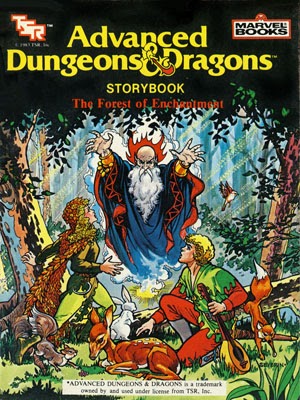
<get that youtube video: Forest and Nature sounds: 10 hours>

<get that youtube video: Forest and Nature sounds: 10 hours>
|
|
|
|
|
|
|
|
|
|
|
|
-
|
|
|
|
|
|
|
|
|
|
|
|
The term "forest" covers
a lot of ground, literally && figuratively.
In the typical campaign
world,
unspoiled by industrial revolutions and
large-scale lumbering operations,
expanses of densely packed trees can be
found in any climate except the polar regions,
where the eternal cold
makes it impossible for trees and other large plants
to survive.
-
Forests in different climatic areas contain
different kinds of
trees: evergreens, or conifers, in the
subarctic; deciduous, or
leaf-bearing, in temperate regions; and
“evergreens” of an entirely
different sort in subtropical and tropical
areas. Characters
may discover a large stand of tall cactus
in the middle of a desert,
but this feature does not qualify as a
forest in game terms; the
area is still considered as desert for
purposes of weather determination,
availability of food and water, and so
forth.
Taiga (Cold Forest) +
Temperate forests contain a wide
variety of trees, all of which
have one important common feature: They
are very adaptable,
able to withstand the scorching heat of
a temperate summer as
well as the vicious deep-freeze of a temperate
winter. Most temperate
forests are composed primarily of deciduous
trees - the
kind that shed their leaves when cold
weather approaches, stand
with branches bared to the winter wind,
and then grow new
leaves when the cold season is over. A
temperate forest is a lush
breeding ground for many types of smaller
plants because the
“crop” of fallen leaves each autumn keeps
the soil rich in nutrients.
However, there are fewer ground plants
and less underbrush
in a temperate forest than in a rainforest,
for the reasons
explained in the following paragraph.
The largest trees in a temperate
forest (usually oak, maple, and ash) can
be as much as
160 feet tall with a “leafspan” nearly
as great as that.

Rainforest
is the name usually given to forests in subtropical
and tropical climates. The distinctive
feature of a rainforest is its
‘‘layered’’ composition; trees of several
different heights coexist
with low-lying shrubs and ferns. Most
of the trees in a rainforest
have thin, straight trunks that stretch
toward the sky and are
topped (in the fashion of an ice-cream
cone or a mushroom) by a
roughly egg-shaped clump of vegetation.
The trees do not spread
out close to the ground the way that trees
in a temperate forest
do, which makes it possible for a rainforest
to support a thick
layer of low-lying vegetation at ground
level. On a sunny day, a lot
of light reaches the floor of a rainforest;
on the same kind of day in
a temperate forest, many areas beneath
wide, tall trees remain
shaded from dawn to dusk. As one might
expect from its name, a
rainforest is also covered with vegetation
because of the large
amount of precipitation the area receives.
Trees in a rainforest
are green all year round; before old leaves
grow large and drop
off, new ones have already appeared to
take their places.
|
|
|
|
|
|
|
|